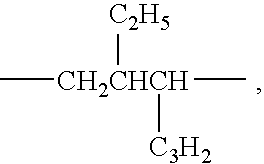Polymeric organometallic films
a polymer and organometallic technology, applied in the field of organometallic films, can solve the problems of film failure, cumbersome procedures, and inability to apply to large surface areas or to continuous methods of application
- Summary
- Abstract
- Description
- Claims
- Application Information
AI Technical Summary
Problems solved by technology
Method used
Image
Examples
example 1
[0044] A polycarbonate plano lens blank coated with a polysiloxane anti-scratch coating (hard coat) was oxidized in an atmospheric plasma apparatus (Lectro Engineering Company Model LTIII) using air and a Corona discharge source for 10 seconds.
[0045] The oxidized lens was then dipped into a 0.25 percent by weight solution of titanium tetra n-butoxide in the monomethylether of propylene glycol, subjected to ultrasonic vibration for 90 seconds (sonification), withdrawn and blown dry with warm air (50° C.), resulting in a film of polymeric titanium oxide with unreacted alkoxide and hydroxyl groups adhered to the lens surface. The treated lens was then dipped in a 0.2 percent by weight solution of poly(hexafluoropropylene oxide) phosphonic acid (number average molecular weight 1582) in a mixed 90 percent by volume methanol 10 percent by volume of HFE-7100, a fluorinated solvent available from the 3M Company and then subjected to ultrasonication for 5 minutes. The lens was withdrawn slo...
example 2
[0047] An oxidized plano lens as described in Example 1 was coated by wiping for 5 seconds with a cellulose tissue (‘Kimwipe’ manufactured by Kimberly Clark) impregnated with a 0.25 percent by weight solution of titanium tetra n-butoxide in dry petroleum distillates (100-140° C. boiling range). This resulted in a strongly bound dry film on the lens surface of polymeric titanium oxide with alkoxide and hydroxyl groups. The lens was wiped with a cellulose tissue impregnated with a 0.2 percent by weight solution of poly(hexafluoropropylene oxide) phosphonic acid solution used in Example 1. Excess material was removed by gently rubbing the surface with a cellulose tissue impregnated with isopropanol. This resulted in a dry film of poly(hexafluoropropylene oxide) phosphonate covalently bonded to the polymeric titanium oxide film. The resultant coating had a water contact angle of 116° and a squalene contact angle of 92° indicating both hydrophobicity and oleophobicity. Test data in Table...
example 3
[0048] An oxidized piano lens as described in Example 1 was coated by spraying with a compressed air sprayer a titanium tetra n-butoxide solution used in Example 2. Spraying was done in one pass at 60 psi and 6 inch distance from the lens to the spray orifice. This resulted in a strongly bound dry film of polymeric titanium oxide with alkoxide and hydroxyl groups on the lens surface. The treated lens was then dipped in the poly(hexafluoropropylene oxide) phosphonic acid solution used in Example 1 and subjected to sonification for 5 minutes. The lens was slowly withdrawn from the solution (2 cm / min) resulting in a dry film of poly(hexafluoropropylene oxide) phosphonate covalently bonded to the polymeric metal oxide film. The composite film was then cured at 120° C. for 10 minutes.
[0049] The coated lens had a water contact angle of about 118° and a squalene contact angle of 90° indicating both hydrophobicity and oleophobicity.
[0050] Test data in Table I below confirmed the composite...
PUM
| Property | Measurement | Unit |
|---|---|---|
| thickness | aaaaa | aaaaa |
| thickness | aaaaa | aaaaa |
| thickness | aaaaa | aaaaa |
Abstract
Description
Claims
Application Information
 Login to View More
Login to View More - R&D
- Intellectual Property
- Life Sciences
- Materials
- Tech Scout
- Unparalleled Data Quality
- Higher Quality Content
- 60% Fewer Hallucinations
Browse by: Latest US Patents, China's latest patents, Technical Efficacy Thesaurus, Application Domain, Technology Topic, Popular Technical Reports.
© 2025 PatSnap. All rights reserved.Legal|Privacy policy|Modern Slavery Act Transparency Statement|Sitemap|About US| Contact US: help@patsnap.com



